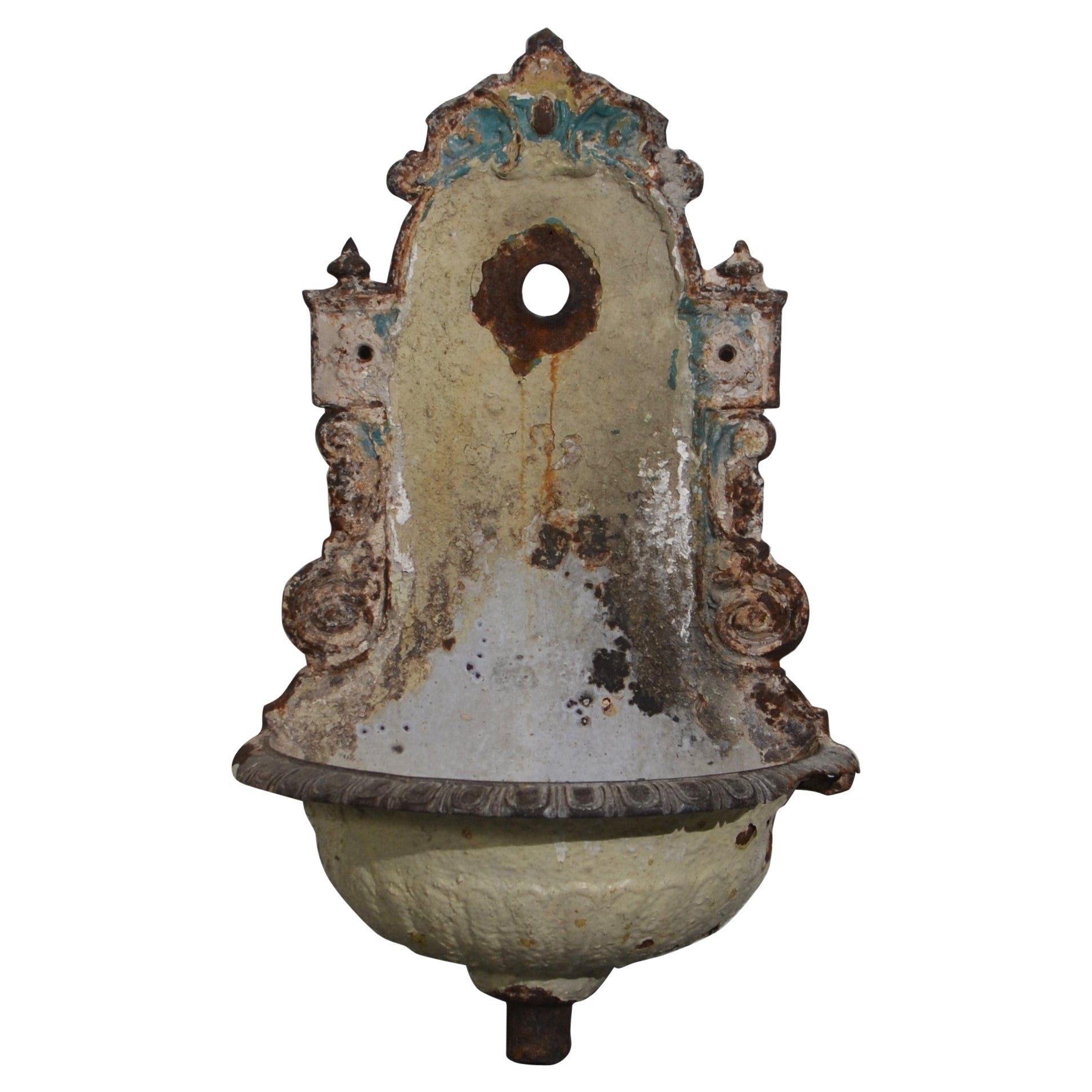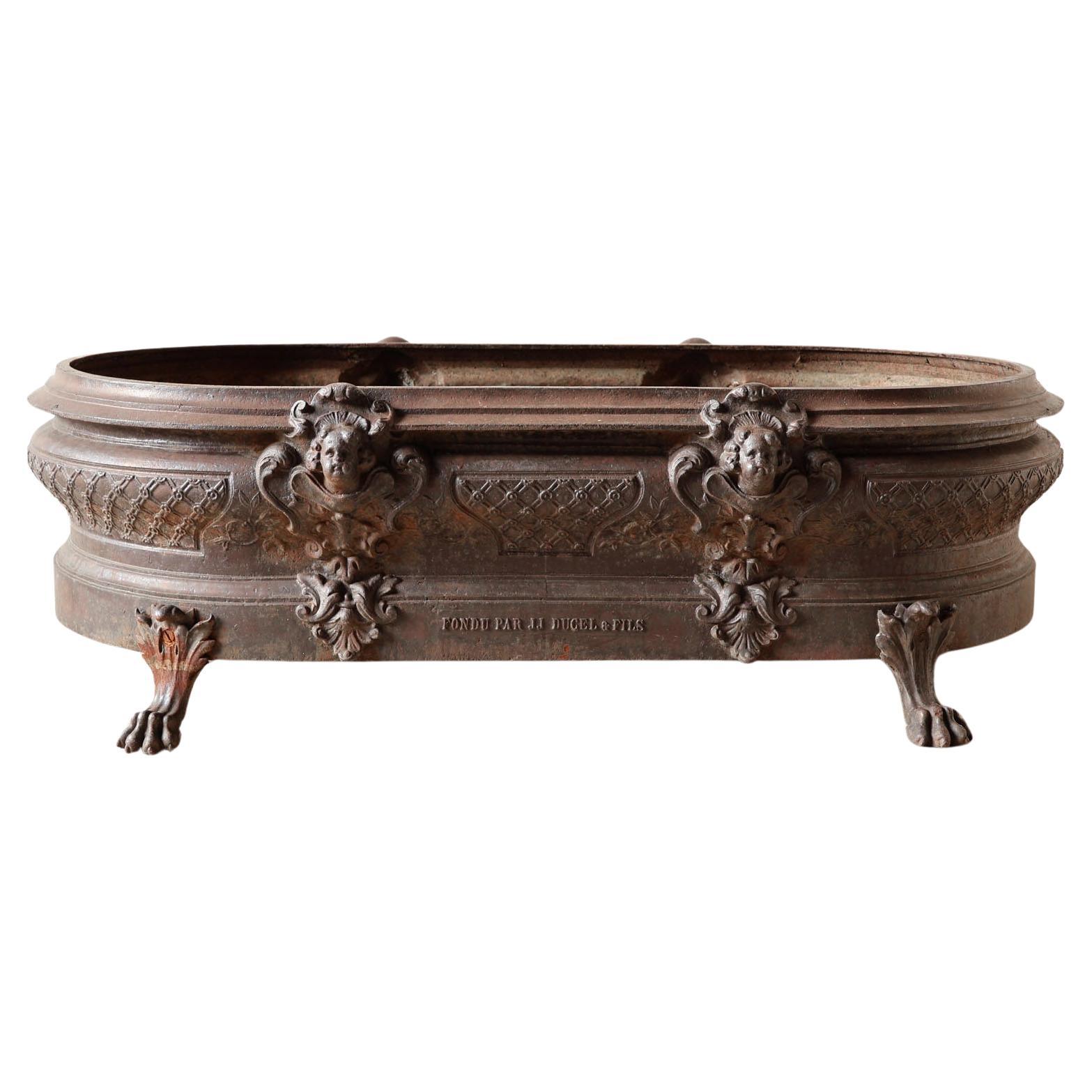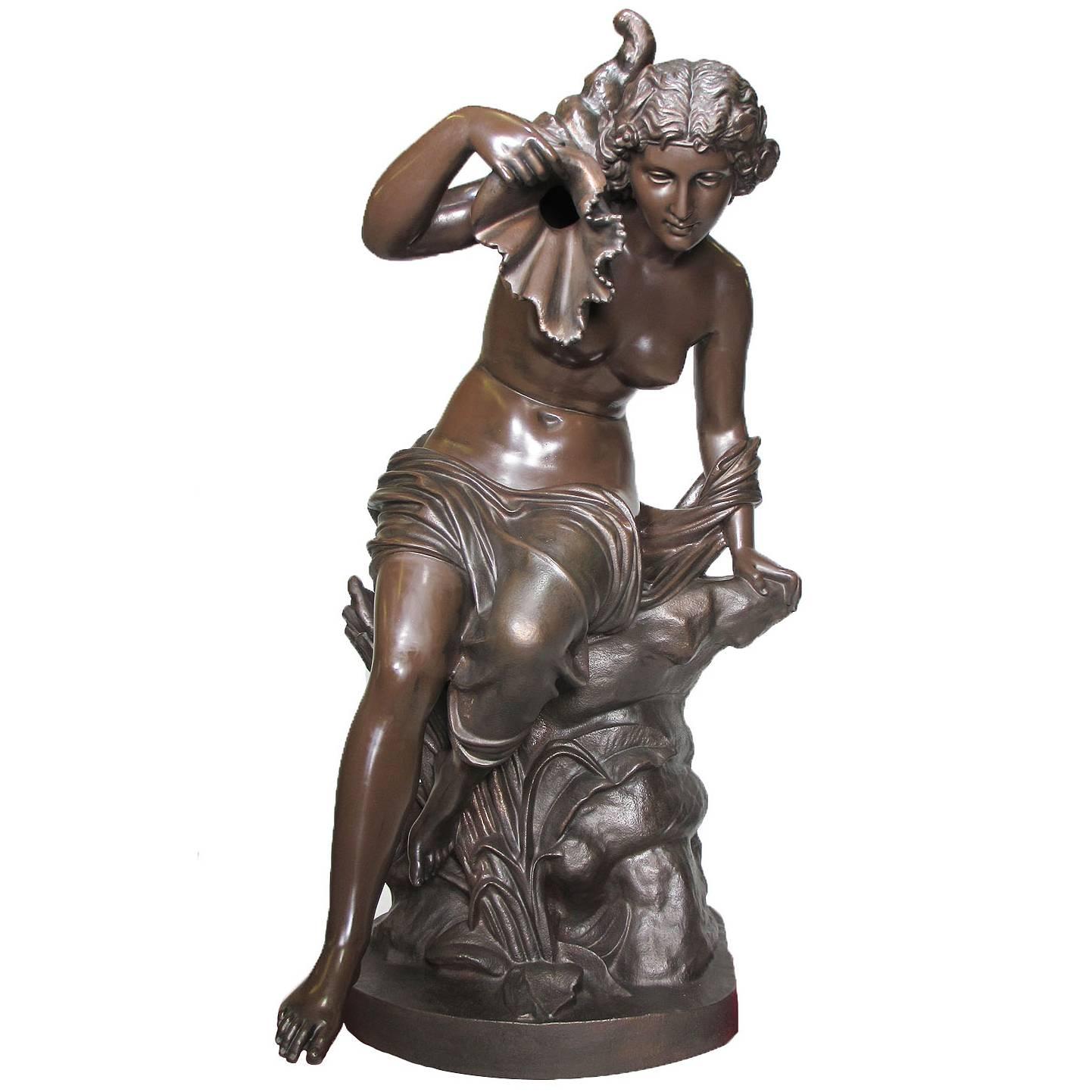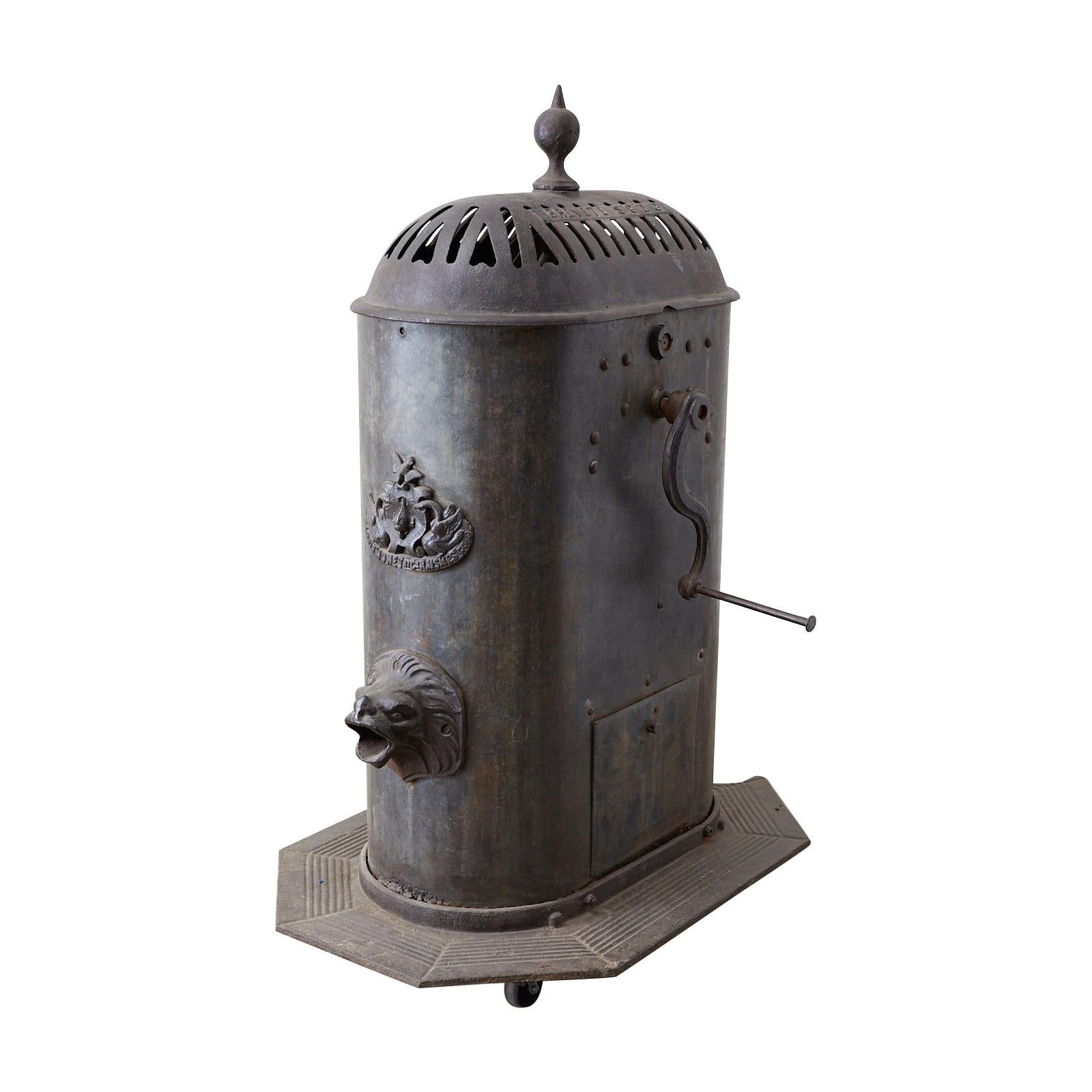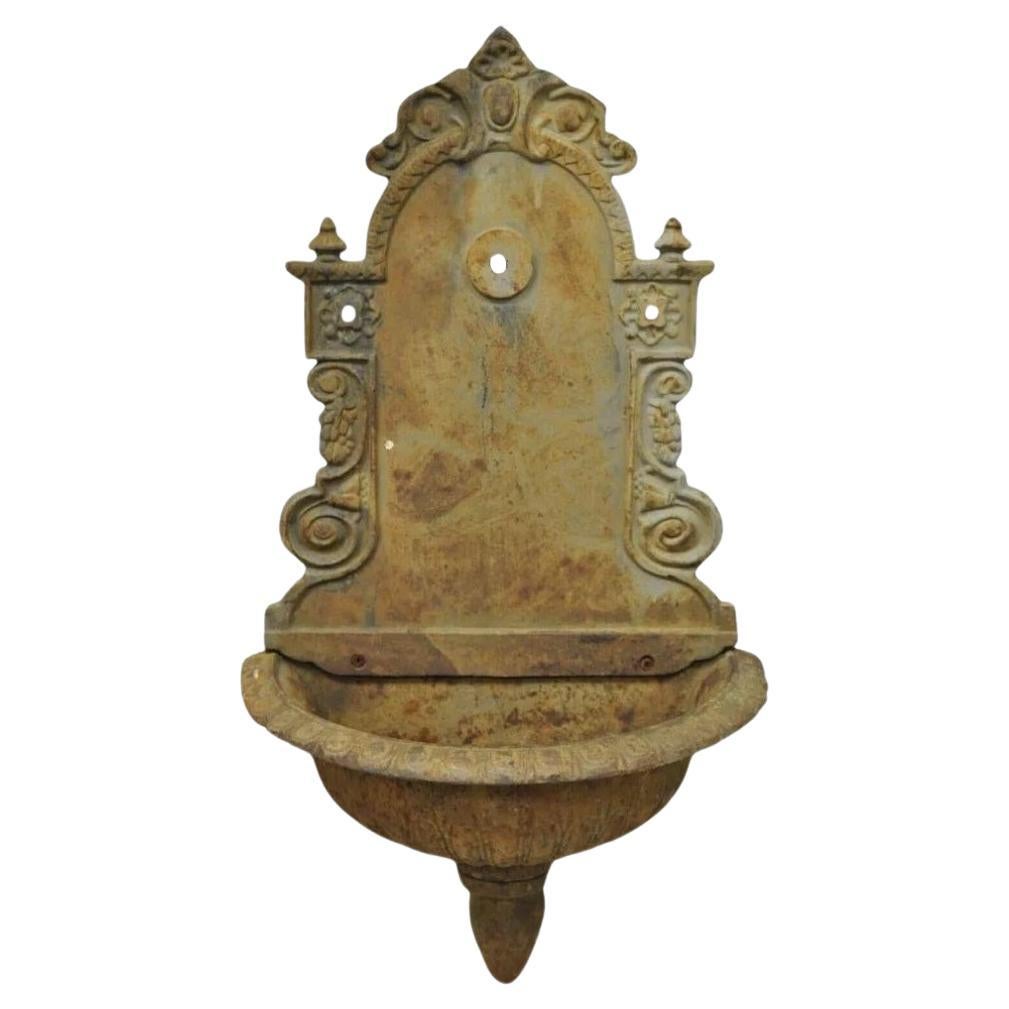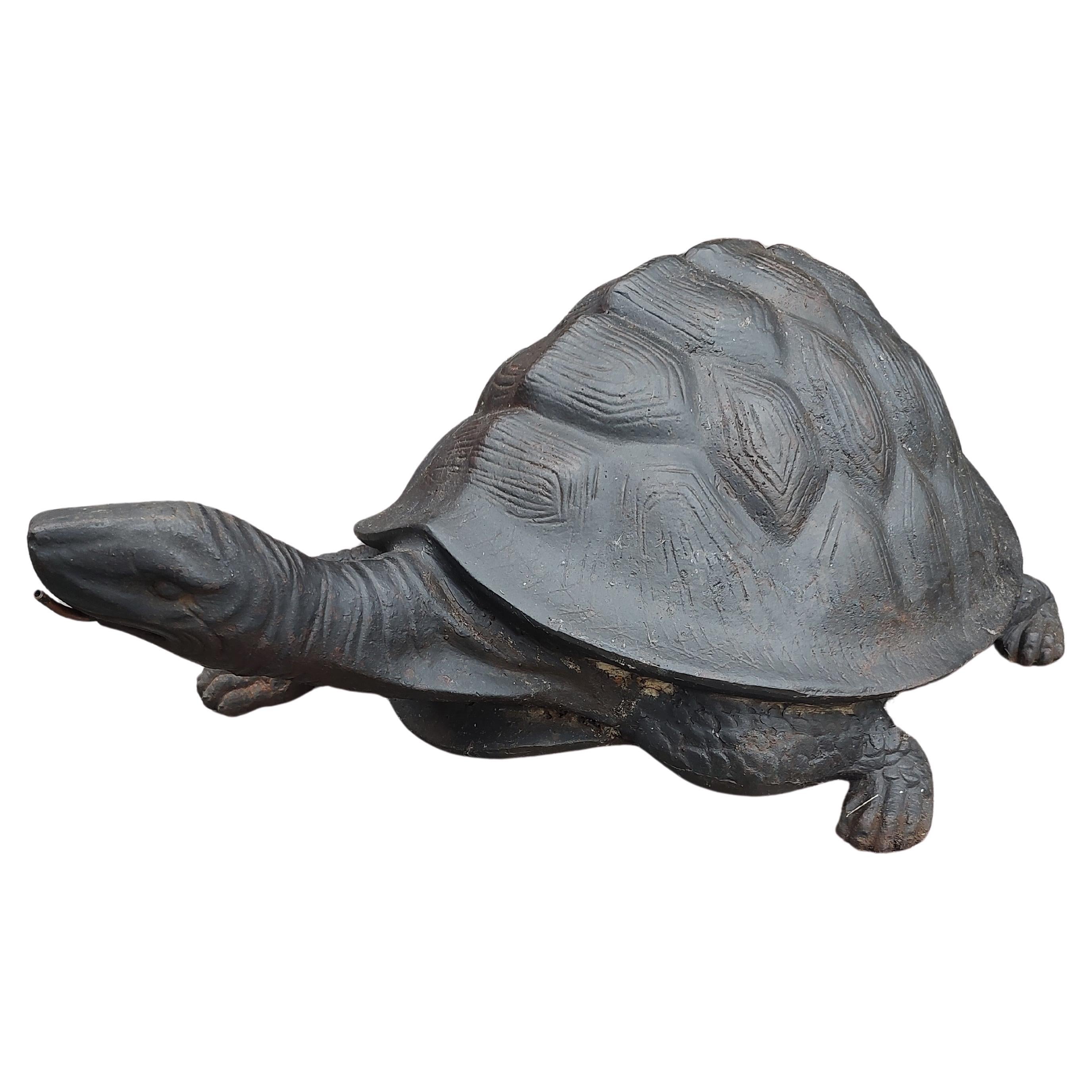Items Similar to A Large Cast Iron Fountain Figure of a Water Nymph, By J.J. Ducel, Paris
Want more images or videos?
Request additional images or videos from the seller
1 of 11
A Large Cast Iron Fountain Figure of a Water Nymph, By J.J. Ducel, Paris
About the Item
A Large Cast Iron Fountain Figure of a Water Nymph On a white marble pedestal, By J.-J. Ducel, Paris.
Signed ' 'J.-J.DUCEL'.
Modelled seated on a rock as if dipping a toe into the water. Holding a conch shell on her left shoulder which is fitted with a water spout.
On a white marble pedestal.
France, Circa 1860.
The statue:
Height : 126 cm | 50 inches
Width : 62 cm | 24 inches
Depth : 65 cm | 26 inches
The Pedestal:
Height : 34 cm | 13 inches
Width : 64 cm | 25 inches
Depth : 64 cm | 25 inches
The Ducel Foundry was started in 1810 and was one of the largest cast iron producers along with Andre and Barbezat & Cie,
The company had premises in Avenue de Forges in Paris and a foundry in Pocé. The firm exhibited at many of the great international exhibitions of the period including the Exposition Universelle de 1867 in Paris where they were received to great acclaim.
Many of the sculptures and ornamental works produced by the firm found favour with newly empowered civic authorities and today many of their best works survive in open public spaces across France.
The foundry stopped production in 1878 after the death of Monsieur Jacques Ducel when all the moulds and patterns were sold to the Val d' Osne foundry.
Literature:
Renard, J. C. L'âge de la Fonte - un art, une industrie 1800-1914.
- Creator:Ducel Foundry (Metalworker)
- Dimensions:Height: 63 in (160 cm)Width: 24.41 in (62 cm)Depth: 25.6 in (65 cm)
- Materials and Techniques:
- Place of Origin:
- Period:
- Date of Manufacture:Circa 1860
- Condition:Wear consistent with age and use.
- Seller Location:Brighton, GB
- Reference Number:
About the Seller
5.0
Recognized Seller
These prestigious sellers are industry leaders and represent the highest echelon for item quality and design.
Platinum Seller
These expertly vetted sellers are 1stDibs' most experienced sellers and are rated highest by our customers.
Established in 1964
1stDibs seller since 2014
48 sales on 1stDibs
Typical response time: 1 hour
Associations
The British Antique Dealers' AssociationLAPADA - The Association of Arts & Antiques Dealers
- ShippingRetrieving quote...Ships From: Brighton, United Kingdom
- Return PolicyA return for this item may be initiated within 7 days of delivery.
More From This SellerView All
- Pair of Large Patinated Bronze Figural Torcheres Cast by Barbedienne, Dated 1872By Émile Guillemin, Ferdinand BarbedienneLocated in Brighton, West SussexA highly important pair of large patinated bronze figural torcheres by Émile Guillemin, cast by Ferdinand Barbedienne. French, dated 1872. Barbedienne Title: 'Deux Femmes, Indi...Category
Antique Late 19th Century French Floor Lamps
MaterialsBronze
- Pair of Gilt & Patinated Bronze Figural Torcheres by Bouchon, Paris, circa 1900Located in Brighton, West SussexA striking pair of gilt and patinated bronze figural torcheres, by Bouchon, Paris. French, circa 1900. Stamped 'BOUCHON PARIS'. Each modelled as a winged male and female fi...Category
Antique Late 19th Century French Torchères
MaterialsBronze
- Emperor Napoleon on Horseback, Cast by Susse Frères, ParisBy Susse FreresLocated in Brighton, West SussexA Large Patinated Bronze Sculpture of Emperor Napoleon on Horseback, Cast by Susse Frères, Paris, From the Model By Alfred Émilien O'Hara, Comte de Nieuwerkerke (1811-1892). Dark br...Category
Antique 19th Century French Figurative Sculptures
MaterialsBronze
- ‘Gloria Victis’, A Patinated Bronze Figural Group by Mercié, Cast by BarbedienneBy Ferdinand BarbedienneLocated in Brighton, West SussexA Patinated Bronze Figural Group of ‘Gloria Victis’ (‘Glory to the Vanquished’), Cast by Ferdinand Barbedienne from the Model by Marius-Jean-Antonin Mercié (French, 1845-1916). ‘Gloria Victis’ (‘Glory to the Vanquished’). Bronze, gilt and dark brown patina. Signed 'A. Mercié', with foundry inscription 'F. BARBEDIENNE, Fondeur. Paris.' and A. Collas reduction cachet. The integral base titled 'GLORIA VICTIS'. This cast is part of a limited edition by the Barbedienne Foundry. France. Circa 1880. ‘Gloria Victis’ is one of the most recognisable and important works of sculpture of the nineteenth century and a definitive image of France’s historic national identity. The figure of glory, winged and wearing armour, carries a dying young warrior heavenwards towards fame and immortality. The compositional daring of the group must be admired for balancing two figures on the minimal support of one foot, wings spread in the moment before taking flight. Mercié was a student at the French Academy of Rome when the Prussians invaded France in 1870. Shortly after the war had begun, he executed a group depicting the figure of Fame supporting a victorious soldier. When news reached Mercié in Rome that the French had surrendered, he decided to alter his group, replacing the victorious soldier with a defeated casualty, thus transforming an allegory of ‘Glory to the Victors’ into one of ‘Glory to the Vanquished’. Completed in 1872, a year after the defeat of French soldiers against the Prussian army, the statue personifies a defeated but heroic France. The title is also a reversal of the famous formula, ‘Vae Victis’ (Death to the Vanquished), which the Gallic general Brennus exclaimed upon defeating the Romans in 390 BC. The figure of the fallen soldier was thought to represent Henri Regnault, a fellow sculptor of Mercié who was killed on the last day of fighting. Measuring 317 cm. high the original group of ‘Gloria Victis’ was unveiled in plaster at the Salon of 1872. It was bought by the City of Paris for the sum of twelve thousand francs and then cast in bronze by Victor Thiébaut for eight thousand five hundred francs. The bronze was exhibited at the Salon in 1875 and first placed in Montholon Square in the 8th arrondissement. In 1884 it was transferred to the courtyard of the Hôtel de Ville and in 1930, it entered the collection of the Musée du Petit Palais, where it can be seen to this day. The Thiébaut Frères foundry also cast Gloria Victis bronzes for the cities of Niort (requested 1881) Bordeaux (requested 1883), Châlons-sur-Marne (today, Châlons-en-Champagne; requested 1890), and Cholet (requested 1901). In 1905, the Danish brewer and art collector Carl Jacobsen was permitted to have an exact cast made of the original sculpture in Paris, on condition that the base was made 2 cm lower and bore the inscription “Original tilhører Paris By” (The original belongs to the City of Paris). It too was cast by the Thiébaut Frères foundry. Gloria Victis was one of Jacobsen’s most important and his last acquisition. Today it has been returned to its original position in the Winter Garden at Glyptoteket, Copenhagen, Denmark. The full-size plaster was shown again at the Paris Expositon universelle of 1878 alongside a bronze reduction by Barbedienne. By this time Antonin Mercié had entered into a commercial edition contract with the Ferdinand Babedienne foundry to produce bronze reductions of Gloria Victis, his most famous work. Gloria Victis is first recorded to have been produced in three sizes and by 1886 Barbedienne’s ‘Catalogue des Bronzes D’Art’ lists six sizes measuring 3/5, 9/20, 7/20, 3/10, 6/25 and 2/10, of the original. These reductions were produced by an invention of Barbedienne’s business partner Achille Collas. The Collas reducing machine was a type of complex mechanical pantograph lathe that enabled sculpture to be mathematically measured and transcribed to scale, in the round, thus making a reduced size plaster from which a bronze could be cast. Mercié's modern sculpture had become an instant classic, even receiving an entry in the Nouveau Larousse Illustré. The success of the group undoubtedly lay in the fact that it was admired not just on an aesthetic level, but also on a patriotic level, particularly in its commemoration of heroism in defeat. Immediately ‘Gloria Victis’ was recognised as a national artwork, capable of arousing patriotism and casts were ordered from Barbedienne as local memorials commemorating the war’s dead for cities across France. ‘Gloria Victis’ was considered so much a part of France’s national identity that for the 1900 Paris Exhibition, Ferdinand Barbedienne’s nephew Gustave Leblanc, loaned a bronze example to feature as part of l’Exposition centennale de l’art français. Literature: For an interesting account of the process of creating a reduction in bronze of the Gloria Victis by Barbedienne and illustrations of the casting and finishing of the bronze see: 'Ferdinand Barbedienne': Theodore Child; Harper's new monthly magazine, Volume 73, Issue 436, September 1886. ‘Contemporary French Sculptors’: The Century, Volume 33, Issue 3, Jan 1887. ‘Modern French Sculpture’: Harper's new monthly magazine, Volume 76, Issue 452, January 1888. S, Lami, ‘Dictionnaire des sculpteurs de l'Ecole française au dix-neuvième siècle’, Tome III. G.-M., Paris, 1914, p. 432. Peter Fusco and H.W. Janson, The Romantics to Rodin: French Nineteenth Century Sculpture from North...Category
Antique 19th Century French Figurative Sculptures
MaterialsBronze
- River Nymphs, After Jean GoujonBy Jean GoujonLocated in Brighton, West SussexA fine pair of patinated bronze figures of River Nymphs, After Jean Goujon. These charming figures are inspired by the nymphs on the monumental ‘Fontai...Category
Antique 19th Century French Figurative Sculptures
MaterialsBronze
- Large Multi-Patinated Bronze Figure of an Arab Warrior by Henri-Honoré PléBy Henri Honoré PléLocated in Brighton, West SussexA Large and Important Multi-Patinated Bronze Figure of an Arab Warrior by Henri Honoré Plé. Signed Henri Plé to the base. The figure is finely modelled as an Arab warrior, with sw...Category
Antique 19th Century French Figurative Sculptures
MaterialsBronze
You May Also Like
- 19th Century French Cast Iron Water FountainLocated in Pomona, CA19th Century French cast iron wall water fountain.Category
Antique Early 19th Century French Fountains
MaterialsIron
- Large Antique Cast Iron Jardinière by J.J. Ducel Paris ± 1880By J.J. DucelLocated in Baambrugge, NLLarge antique cast iron jardinière, richly decorated with angel heads and lion paws. This rare French planter was cast and stamped by J.J. Ducel Paris ± 1880. Beautiful for the entra...Category
Antique 1880s French Planters and Jardinieres
MaterialsIron
- Large French 19th Century Cast-Iron Fountain Figure of a Seated Nude MaidenBy J.J. Ducel Me de Forges 1Located in Los Angeles, CAA Fine and Large French 19th Century Cast-Iron Fountain Figure Modeled as a Nude Maiden Seated on a Rocky Outcrop Holding a Cornucopia in Her Raised Right Hand, by J.J Ducel. Cast-Signed "J.J. DUCEL Me de FORGES, PARIS". Circa: Paris, 1880. A retailer of fine cast-iron ornaments, J. J. Ducel was recorded as supplying cast-iron works through Paris as early as 1810 in the Pas-de-Calais. The factory was sold in 1878 to the Fonderie de la Haute-Marne and all of the firm's models were subsequently bought by the Val d'Osne foundry. However, prior to the firm's sale, critics at the 1867 Paris Exposition Universelle proclaimed that "Ducel is the great manufacturer of works in cast-iron, to whom Paris is so largely indebted for the grace and elegance that supply so many of the adornments of its streets". Ducel, Val d'Osne and other associated foundries produced both bronze and cast-iron statuary. Cast-iron is corrosive, whereas non-ferrous bronze does not suffer the same detrimental effects of weathering and is therefore a superior and more expensive material. Height: 51 1/2 inches (130.8 cm) Width: 22 inches (55.9 cm) Depth: 30 inches (76.2 cm) The foundry of Val d'Osne became highly regarded for the varied nature and quality of its castings in the second half of the 19th century. Commonly known after 1870 as simply Val D'Osne, the company was originally founded by J.P.V. André in Val d'Osne 1835 and developed rapidly, absorbing smaller foundries in the Haute-Marne area east of Paris. The foundry contributed to the London International Exhibition of 1851, where a bronze fountain cast with classical figures attracted much attention. André also specialised in fancy castings and architectural fittings. His Paris adress was at 14 Rue Neuve, Menilmontant. In 1855 the Barbezat & Cie Foundry was born out of the André workshop. In 1867 Barbezat & Cie changed its name to Houille & Cie. Then, in 1870, it changed its name to Société Anonyme du Val d'Osne. With the change of name came the change of casting mark and adress: Fonderies d'Art du Val d'Osne, 58 Bd Voltaire, Paris or simply Val d'Osne. Cast-iron had been in production during the 18th century but its inferior status to the more fashionable and delicate wrought-iron had generally confined its use to architectural work. By the early 19th century, however, rapid developments of the Industrial Revolution combined with the simultaneous burgeoning of a new middle class provided the impetus for a dramatic expansion in its application and in a short space of time a proliferation of iron foundries across Europe and America thrived on the production of everything from inkstands to railway stations. The use of cast-iron for garden ornament became particularly widespread at this time, as the possibilities for its mass-production at a fraction of the cost of bronze made it the material of choice for indoor/outdoor statuary...Category
Antique 19th Century French Classical Greek Figurative Sculptures
MaterialsIron
- 19th Century French Cast Iron Water Pump FountainLocated in Rio Vista, CAMonumental 19th century French water pump fountain made by Louis Jonet. This large cast iron piece would have been mounted above a large stone trough to catch water. Reminiscent of t...Category
Antique 19th Century French Napoleon III Fountains
MaterialsIron
- Cast Iron French Empire Neoclassical Style Outdoor Garden Wall Water FountainLocated in Philadelphia, PACast Iron French Empire Neoclassical Style Outdoor Garden Wall Water Fountain. Item featured is a heavy cast iron construction, desirable weathered...Category
Late 20th Century Neoclassical Fountains
MaterialsIron
- Pair of Large Cast Iron Patinated Turtles Garden Fountains C1980By Fiske Or MottLocated in Port Jervis, NYFabulous pair of cast iron garden turtle fountains. Each turtle measures at 25 x 14 x 10h inches. Hefty in weight, very stable. Copper tubing for the water spout. Great detailed cast...Category
Vintage 1980s American Adirondack Fountains
MaterialsCopper, Iron
Recently Viewed
View AllMore Ways To Browse
Frog Fountain Spout
Stone Basin Pedestal
Koi Fountain
Hand Water Pump
Stone Light Fountain
Italian Stone Outdoor Fountain
Lion Fountain Masks
Pewter Dolphin
Antique Garden Pump
Fountain Tub
Stone Fountain Masks
Cast Iron Lion Fountain
Cast Iron Pump
Round Hand Carved Water Fountain
Limestone Firepit
Antique Bronze Faucet
Antique Cast Iron Pumps
Antique Basin Faucet
